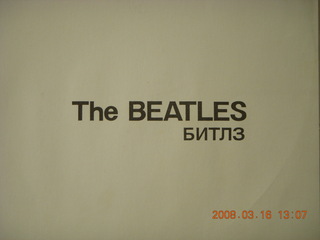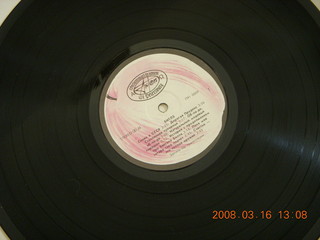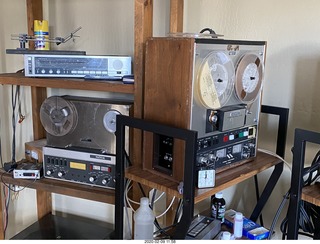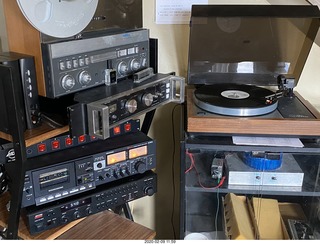ORGANIZING MY RECORD COLLECTION
2021 January 20, Wednesday
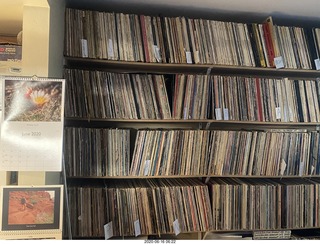 When I was a teenager I bought records.
These were twelve-inch (30.5 cm), black-plastic-vinyl disks
with grooves on both sides
that played music (or other sound)
at 33⅓ revolutions per minute,
1.8 seconds per revolution.
Do the math, 1000 revolutions
of the tightly-spiraled microgroove
is half an hour of audio material.
When I was a teenager I bought records.
These were twelve-inch (30.5 cm), black-plastic-vinyl disks
with grooves on both sides
that played music (or other sound)
at 33⅓ revolutions per minute,
1.8 seconds per revolution.
Do the math, 1000 revolutions
of the tightly-spiraled microgroove
is half an hour of audio material.
We didn't call them "vinyls" in those days.
Instead we called them "albums,"
an allusion to the actual
albums
of shellac 78-RPM
records
my parents used to play.
Some older people called them "LPs" for Long Play
in contrast to the shorter-play 78s
or doughnut-hole 45-RPM singles.
A kid got a record, then another and another,
and piled up to a few dozen records next to a record player.
Somehow the teenager
found
a wooden orange crate or a plastic milk crate
and the records are sorted for flipping through them so
Abba is in the front and ZZ-Top is in the back of the crate.
Behind Abba are the Beatles records
with Creedence Clearwater Revival and Donovan behind.
There are a lot of S records like Steppenwolf and Supertramp.
Soon the crate gets full enough that it takes two hands
to extract a record and it's time to expand.
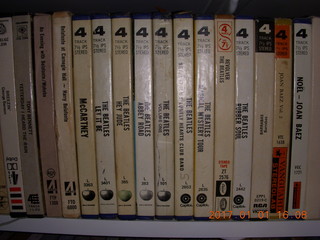 One could go to two crates or even three crates,
but at some point the burgeoning record collection
went onto a horizontal shelf.
The owner could reverse the order so
Abba is on the left and ZZ-Top is on the right,
but that's too much like work,
so the collection was picked up in handfuls
and deposited on the shelf in the same order
which now puts Abba on the right and ZZ-Top on the left.
When you see a collection of ten thousand records
going right to left, it's not an ethnic thing.
You can smile with the satisfaction of knowing
this collection probably started
in a wooden orange crate or a plastic milk crate.
Mine isn't the only record collection
that goes right to left.
One could go to two crates or even three crates,
but at some point the burgeoning record collection
went onto a horizontal shelf.
The owner could reverse the order so
Abba is on the left and ZZ-Top is on the right,
but that's too much like work,
so the collection was picked up in handfuls
and deposited on the shelf in the same order
which now puts Abba on the right and ZZ-Top on the left.
When you see a collection of ten thousand records
going right to left, it's not an ethnic thing.
You can smile with the satisfaction of knowing
this collection probably started
in a wooden orange crate or a plastic milk crate.
Mine isn't the only record collection
that goes right to left.
I have a friend who has about one thousand records
distributed somewhat
randomly
on various piles and shelves in his
listening room with recently-played records scattered
on the floor.
He's comfortable with that,
"I go to a pile of records and grab one
I feel like listening to."
It works for him, but I wanted to listen to
Steely Dan's "Aja" about a month ago,
then Dave Brubeck's "Time Further Out,"
and then Cesar Franck's Symphony in D minor.
I have five hundred reel-to-reel tapes
in my published-album collection
and two hundred larger reels of "master-dub" recordings
copied fresh from some kind of master recording,
but the main collection is four thousand records.
I want to be able to find a record on demand.
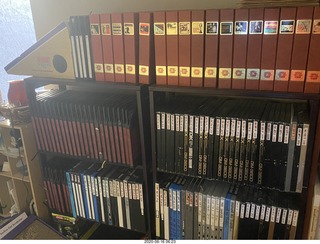 So we need a sorting process that has
an unambiguous algorithm for sorting records.
For any two records there has to be a decisive choice
which one goes first and which second
with the extra feature
that A-before-B and B-before-C implies A-before-C.
(We math geeks call the latter "transitivity.")
There are many sorting-algorithm choices out there.
One friend does it simply by label and number,
so Deutsche-Grammophon comes before Philips
which comes before Seraphim
and number 136300 comes before 138829.
I figure he puts 13829 before 136300
because 13 829 is a smaller number than 136 300
and 138829 before DGT8978 because numbers come before letters,
but it only matters that he knows the rule and enforces it.
The obvious weakness of that system
is that one must possess a great knowledge
of record catalogues to know that DGG DGT8978
is the Bach "Brandenburg Concertos"
and "2 Suites for Orchestra"
with the Berlin Philharmonic
conducted by Herbert von Karajan.
So we need a sorting process that has
an unambiguous algorithm for sorting records.
For any two records there has to be a decisive choice
which one goes first and which second
with the extra feature
that A-before-B and B-before-C implies A-before-C.
(We math geeks call the latter "transitivity.")
There are many sorting-algorithm choices out there.
One friend does it simply by label and number,
so Deutsche-Grammophon comes before Philips
which comes before Seraphim
and number 136300 comes before 138829.
I figure he puts 13829 before 136300
because 13 829 is a smaller number than 136 300
and 138829 before DGT8978 because numbers come before letters,
but it only matters that he knows the rule and enforces it.
The obvious weakness of that system
is that one must possess a great knowledge
of record catalogues to know that DGG DGT8978
is the Bach "Brandenburg Concertos"
and "2 Suites for Orchestra"
with the Berlin Philharmonic
conducted by Herbert von Karajan.
The more common approach is to sort alphabetically,
Bach before Beethoven and Beach Boys before Beatles.
My own taste forbids me from having those four in order
Bach,
Beach Boys,
Beatles, and
Beethoven.
At first I kept
categories
separate.
Classical by Composer
Classical by Performer
Classical Collection
Blues
Country
Folk
Jazz
Popular
International by Country
Movies and Shows
Audiophile
I use "Popular" instead of "Rock and Roll."
Then I found myself pondering where a particular
non-classical artist belongs.
Is Steely Dan jazz or popular?
Is Cat Stevens folk or popular?
What about non-classical artists who cross over.
Linda Ronstadt finds herself in several of these categories.
Should I scatter her records in several different places?
I've simplified the list by putting the non-classical stuff
all together on my record-collection wall.
Classical by Composer
Classical by Performer
Classical by Title
Classical Collection
General
International by Country
Movies and Shows
Audiophile
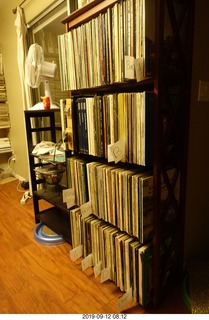 Actually, there is a bigger umbrella than Category.
My collection has several media,
vinyl records,
compact disks (CDs),
various sorts of reel-to-reel tape,
and a few compact cassettes.
They live in different places in my house.
"Abbey Road" may go under B for Beatles,
but it's in two places,
vinyl-record and quarter-track reel-to-reel.
Actually, there is a bigger umbrella than Category.
My collection has several media,
vinyl records,
compact disks (CDs),
various sorts of reel-to-reel tape,
and a few compact cassettes.
They live in different places in my house.
"Abbey Road" may go under B for Beatles,
but it's in two places,
vinyl-record and quarter-track reel-to-reel.
Classical record go by composer's last name,
Bach, Beethoven, and Brahms under B
and Mozart under M.
Records with multiple composers get my best-informed choice,
the one that dominates the record or the one more famous
or the one most interesting.
I haven't found myself struggling with that one.
Records where the performer is more important than the composer
tend still to go under the composer when there is just one composer
and under the artist in "Classical by Artist" otherwise.
If a record's title is more important than its composer or artist,
"Great Piano Works" for example,
then I have smaller categories
"Classical by Title" and "Classical Collection."
International records go by their place,
a country, sometimes a continent, occasionally an ethnic group.
Movies and shows go by their title,
"Alfie" to "You Are What You Eat."
(Yes, I have the record of that one
with Tiny Tim.)
Now comes another issue:
How do I alphabetize the artists?
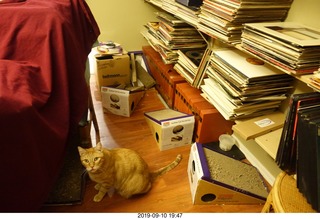 The easiest issue is to remove the leading "the"
from the Beatles, the Doors,
the Hollies, et cetera
so they would go under B, D, and H.
(In prose I don't capitalize
the leading "the" in band names.)
I don't have any examples of a leading "a" in an artist's name,
but I would similarly remove it,
so a group called A New Light
would go under N.
I think that part is easy.
The easiest issue is to remove the leading "the"
from the Beatles, the Doors,
the Hollies, et cetera
so they would go under B, D, and H.
(In prose I don't capitalize
the leading "the" in band names.)
I don't have any examples of a leading "a" in an artist's name,
but I would similarly remove it,
so a group called A New Light
would go under N.
I think that part is easy.
Old time computer programmers were trained on mainframe computers
using Extended Binary Coded Decimal Interchange Code (EBCDIC)
would tend to put numbers after letters in alphabetical-numeric order,
but I'm young enough to have used the
American Standard Code For Information Interchange (ASCII)
that puts numbers before letters,
so I put 10cc before
any popular group beginning with a letter.
(I haven't found any examples in my collection
of numeric quantity sorting
like whether I should put 11000 Virgins before
or after The 5th Dimension,
but I would put them in numerical rather than
lexicographical order,
8 before 32 before 128 before 10000.)
Three Dog Night is under T
because they spell out the number.
I put people under their last, family names.
July Collins and Jim Croce are under C,
John Mayall and Joni Mitchell go under M.
For no other reason than tradition I found myself
putting van under V
(Thijs van Leer,
Art Van Damme, and
Dave Van Ronk)
and Maestro Herbert von Karajan under K.
What if the name isn't the name of a real person?
I put Elton John under E
before he changed his name
from Reginald Kenneth Dwight
to Elton Hercules John
and I have kept his records under E.
Alice Cooper is under A.
I put Jethro Tull under J because
the person Jethro Tull (1674-1741)
was an English agricultural innovator
not famous in any way for music.
 Just because there are two words in the name
doesn't change my using the first letter.
Steely Dan goes under S next to
Steeleye Span and Steppenwolf.
I keep Cat Stevens in the same S neighborhood,
never mind what name changes he did later on.
Just because there are two words in the name
doesn't change my using the first letter.
Steely Dan goes under S next to
Steeleye Span and Steppenwolf.
I keep Cat Stevens in the same S neighborhood,
never mind what name changes he did later on.
Some of it has to do with heritage and numbers.
When the Beatles broke up and
Paul McCartney had his own album,
I put the singular McCartney
under B to go with the Beatles.
When he had a second and third record in my collection,
I moved Paul McCartney under M.
I still keep (Noel) Paul Stookey,
Mary Travers, and Peter Yarrow
under P for Peter, Paul and Mary.
I just got Peter Tork's record
"Stranger Things Have Happened"
and it's going under M for Monkees.
Jon & Vangalis is under A in my collection.
It's Jon Anderson and it goes
with other Jon Anderson records.
It's where I would think to look for it.
The Audiophile records are by label,
Sheffield, Proprius, Opus 3, Mark Levinson,
Mobile Fidelity Sound Labs, Nautilus, Crystal Clear,
et cetera.
I put some special labels like
Mercury Living Presence ("Mercs"), RCA Living Stereo
("dogs"), and BIS
on the audiophile-labels shelf.
I consider few of these decision to be "right" enough
to say doing it another way is "wrong."
Somebody who puts Elton John under J,
Jethro Tull under T,
and Fleetwood Mac under M
is doing it differently from me,
but that doesn't make it wrong.
So when does one become a "collector"?
When do the records or CDs on the wall become a "collection"?
Some if it is numbers.
My 4000 records are a collection, that's easy,
more than a small collection but far short of a large one.
People with tens of thousands of records
are "real collectors" in my book.
I keep 500 factory-issue reel tapes,
enough to be a collection.
With vinyl including a few at 45 RPM,
three formats of reel tape,
compact cassettes,
and compact disks (CDs),
I guess I have seven media
and I listen regularly to all of them.
(I turned my CD collection into FLAC files
with the original disks in storage,
but I still count them as a medium.)
Somebody who buys a record that will never be played
is a collector.
I have a "The Return of Bruno" by Bruce Willis.
It's in the shrink wrap,
I figure it's awful,
but I couldn't resist buying it for fifty cents.
If a copy of William Shatner's record
with his truly-awful version
of "Lucy in the Sky with Diamonds"
should cross my path, then I'll likely get it.
I have multiple pressings of
Pink Floyd "Dark Side of the Moon"
including, only recently,
the most-treasured British stereo EMI pressing from 1973.
I have a white-label of Supertramp "Crime of the Century."
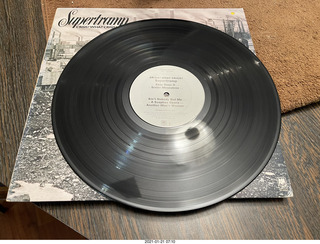 A "white label" pressing is one of those
sent to a radio station before the record appeared in stores.
They're usually printed on a white label, no background color,
with an admonition "PROMOTIONAL COPY - NOT FOR SALE."
They tend to sound better since they are early pressings.
Record masters are cut on a lathe
and go through various stages before they're
pressed onto vinyl and stuffed into sleeves and covers.
On the inner blank space is usually written a
matrix number
of what stamping and pressing the record is
with something like
1A
being first and most-treasured.
A "white label" pressing is one of those
sent to a radio station before the record appeared in stores.
They're usually printed on a white label, no background color,
with an admonition "PROMOTIONAL COPY - NOT FOR SALE."
They tend to sound better since they are early pressings.
Record masters are cut on a lathe
and go through various stages before they're
pressed onto vinyl and stuffed into sleeves and covers.
On the inner blank space is usually written a
matrix number
of what stamping and pressing the record is
with something like
1A
being first and most-treasured.
One euphemism I love is "fan club issue."
It's a nicer term for so-called "bootleg" recordings,
usually made without permission of the performing artists.
The Grateful Dead were happy to have concertgoers
record their concerts,
sometimes to the point of offering signal feeds
from the sound system,
but most artists have preferred
to limit distribution of their recordings
to their own productions.
These bootlegs make their way to used record stores
and are sometimes sold under a category of fan club issue.
Another sure symptom of being a collector
rather than merely a music lover with a lot of recordings
is buying the same content with a different cover.
I don't do this often,
but I have done this once or twice
with a really-terrific record like
"The Friends of Mr. Cairo" by Jon & Vangalis.
My friend
Earl Root,
who sold me many of the records in my collection,
joked that he would make a special collector's package
of all seventy-two covers of "Synchronicity" by The Police.
Here
is my own collection transcribed to a TeX file and then to PDF.
There are mistakes, "typos" and misclassifications, to be sure.
With the advantage of computer search for a PDF file
I make finer classifications than
I make on the shelves with the actual vinyl.
I expend only modest effort keeping it up to date,
but every new acquisition gets put in there.
THE ADAM HOME PAGE
adam@the-adam.com
 When I was a teenager I bought records.
These were twelve-inch (30.5 cm), black-plastic-vinyl disks
with grooves on both sides
that played music (or other sound)
at 33⅓ revolutions per minute,
1.8 seconds per revolution.
Do the math, 1000 revolutions
of the tightly-spiraled microgroove
is half an hour of audio material.
When I was a teenager I bought records.
These were twelve-inch (30.5 cm), black-plastic-vinyl disks
with grooves on both sides
that played music (or other sound)
at 33⅓ revolutions per minute,
1.8 seconds per revolution.
Do the math, 1000 revolutions
of the tightly-spiraled microgroove
is half an hour of audio material.





